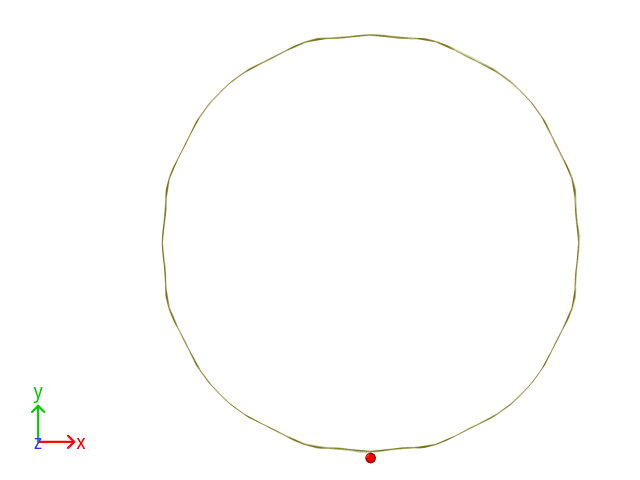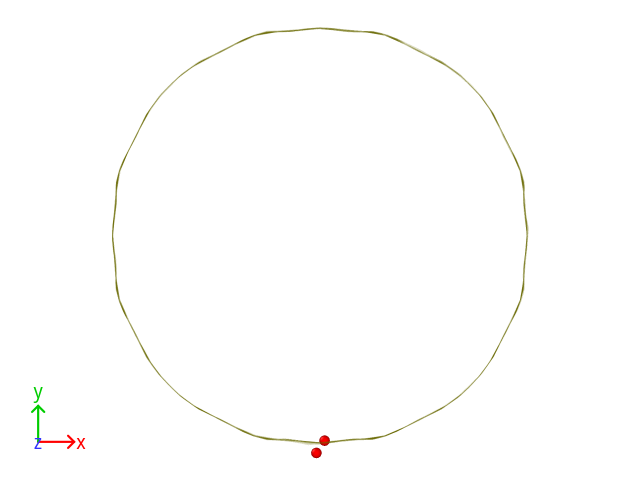Dear Lammps users
I am trying to simulate ion impact with materials and my system is a cylinder and s s p boundary condition is applied. I am using Au_u3.eam potential file and in the short range it has been smoothly changed to ZBL potential. The high energy PKA atom is created at (r,0,l/2), in which r represents radius and l represents length of the cylinder, respectively.
In some cases of my simulation, I found the results are unreasonable. Pictures of frame 0 to frame 2, which is at the very beginning of the cascade, are in the attachments. Atoms with kinetic energy greater than 100eV are shown in the frames; the others are deleted.
Frame 0 represents timestep 0, there is one atom in the picture, which is the PKA. The position is (0,-40.8,89.76), the atom ID is 55309, kinetic energy is 998.286eV, potential energy is 4586.15eV.
Frame 1 represents timestep 100 and time 0.001977ps, there are two atoms in the picture. Atom 1: atom ID 55309, position (-0.687876,-41.4645,90.0616), KE 3334.36eV and PE -2.18063eV. Atom 2: atom ID 33661, position (0.879892,-39.118,89.3737), KE 6813.03eV and PE 0.163544eV.
Frame 2 represents timestep 200 and time 0.003814ps, three atoms are there. Atom 1: atom ID 55309, position (-1.38614,-42.1862,90.3678), KE 3333.24eV and PE -0.898556eV. Atom 2: atom ID 33661, position (1.57332,-37.8237,89.0671), KE 6801.14eV and PE 7.43033eV. Atom 3: atom ID 16391, position (40.8651,-0.554037,44.3295), KE 101.024eV and PE 2.45243eV.
I think there are two unreasonable results here:
1. In frame 1, the kinetic energies of the two atoms are much greater than the initial PKA’s KE. 3334.36+6813.03=10147.39eV is nearly ten times of PKA's KE 1keV.
2. In frame 2, there is one atom with high KE but located far away from PKA. Atom 3 (ID 16391) is at the other side the cylinder's surface. It is impossible for the PKA to collide with it in such a short time.
I cannot figure out why these happened. Could anyone please tell me whether these are reasonable or not, and how can I fix this?
Any help would be much appreciated!
With My Best Regards
Wenqiang Liu



Dear Lammps users
I am trying to simulate ion impact with materials and my system
is a cylinder and s s p boundary condition is applied. I am using Au_u3.eam
potential file and in the short range it has been smoothly changed to ZBL
potential. The high energy PKA atom is created at (r,0,l/2), in which r
represents radius and l represents length of the cylinder, respectively.
In some cases of my simulation, I found the results are
unreasonable. Pictures of frame 0 to frame 2, which is at the very
beginning of the cascade, are in the attachments. Atoms with kinetic energy
greater than 100eV are shown in the frames; the others are deleted.
Frame 0 represents timestep 0, there is one atom in the picture,
which is the PKA. The position is (0,-40.8,89.76), the atom ID is 55309,
kinetic energy is 998.286eV, potential energy is 4586.15eV.
Frame 1 represents timestep 100 and time 0.001977ps, there are
two atoms in the picture. Atom 1: atom ID 55309, position
(-0.687876,-41.4645,90.0616), KE 3334.36eV and PE -2.18063eV. Atom 2: atom
ID 33661, position (0.879892,-39.118,89.3737), KE 6813.03eV and PE
0.163544eV.
Frame 2 represents timestep 200 and time 0.003814ps, three atoms
are there. Atom 1: atom ID 55309, position (-1.38614,-42.1862,90.3678), KE
3333.24eV and PE -0.898556eV. Atom 2: atom ID 33661, position
(1.57332,-37.8237,89.0671), KE 6801.14eV and PE 7.43033eV. Atom 3: atom ID
16391, position (40.8651,-0.554037,44.3295), KE 101.024eV and PE 2.45243eV.
I think there are two unreasonable results here:
1. In frame 1, the kinetic energies of the two atoms are much
greater than the initial PKA’s KE. 3334.36+6813.03=10147.39eV is nearly ten
times of PKA's KE 1keV.
There is no reason that kinetic energy should conserve, correct? Note it
is the total energy that is the conserved quantity - provided that you have
an energy-conserving model without the PKA.
2. In frame 2, there is one atom with high KE but located far away
from PKA. Atom 3 (ID 16391) is at the other side the cylinder's surface. It
is impossible for the PKA to collide with it in such a short time.
Does this occur without the PKA? Why are there atoms outside the surface?
One possible reason is that your surface expanded and that particular atom
was somehow pushed away by its neighbors.
Ray


